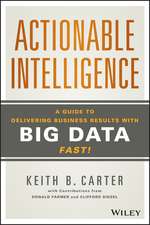Multiobjective Optimization: Behavioral and Computational Considerations
Autor Jeffrey L. Ringuesten Limba Engleză Paperback – 23 oct 2012
| Toate formatele și edițiile | Preț | Express |
|---|---|---|
| Paperback (1) | 381.43 lei 6-8 săpt. | |
| Springer Us – 23 oct 2012 | 381.43 lei 6-8 săpt. | |
| Hardback (1) | 579.34 lei 6-8 săpt. | |
| – | 579.34 lei 6-8 săpt. |
Preț: 381.43 lei
Nou
Puncte Express: 572
Preț estimativ în valută:
72.99€ • 76.11$ • 60.67£
72.99€ • 76.11$ • 60.67£
Carte tipărită la comandă
Livrare economică 20 martie-03 aprilie
Preluare comenzi: 021 569.72.76
Specificații
ISBN-13: 9781461366058
ISBN-10: 1461366054
Pagini: 188
Ilustrații: XV, 169 p.
Dimensiuni: 152 x 229 x 10 mm
Greutate: 0.26 kg
Ediția:Softcover reprint of the original 1st ed. 1992
Editura: Springer Us
Colecția Springer
Locul publicării:New York, NY, United States
ISBN-10: 1461366054
Pagini: 188
Ilustrații: XV, 169 p.
Dimensiuni: 152 x 229 x 10 mm
Greutate: 0.26 kg
Ediția:Softcover reprint of the original 1st ed. 1992
Editura: Springer Us
Colecția Springer
Locul publicării:New York, NY, United States
Public țintă
ResearchCuprins
1. Introduction.- 1.1 Multiple-Objective Optimization.- 1.2 Dominance And Efficiency.- 1.3 Multiattribute Value And Utility Theory.- 1.4 Functional Forms And Independence Conditions.- 1.5 Value Functions As Compared To Utility Functions.- 1.6 Optimizing The Multiattribute Utility Or Value Function.- 1.7 References.- 1.8 Other Relevant Readings.- 2. Linear Goal Programming.- 2.1 The Goal Programming Model.- 2.2 Aspiration Levels.- 2.3 Weights.- 2.4 Preemptive Priorities.- 2.5 Multiattribute Value Theory.- 2.6 Specifying The Weights In An Additive Value Function.- 2.7 Sensitivity Analysis.- 2.8 References.- 2.9 Other Relevant Readings.- 3. Generalizing Goal Programming.- 3.1 Linear Goal Programming.- 3.2 Piecewise Linear Approximations Of Single Attribute Value Functions.- 3.3 Goal Programming With A Multiplicative Value Function.- 3.4 Nonlinear Goal Programming.- 3.5 References.- 4. Compromise Programming.- 4.1 Ideal Solutions.- 4.2 Compromise Functions.- 4.3 Compromise Solutions And The Compromise Set.- 4.4 The Anti-Ideal And Compromise Programming.- 4.5 The Method Of The Displaced Ideal.- 4.6 Compromise Programming, Linear Goal Programming, And Multiattribute Value Functions.- 4.7 References.- 5. Decision Making and the Efficient Set.- 5.1 The Efficient Set.- 5.2 Intra-Set Point Generation.- 5.3 Filtering.- 5.4 Clustering.- 5.5 Matching And Grouping.- 5.6 Sectioning.- 5.7 A Stochastic Screening Approach.- 5.8 References.- 5.9 Other Relevant Readings.- 6. Interactive Methods.- 6.1 The General Interactive Approach.- 6.2 Examples Of Interactive Methods.- 6.3 Simplified Interactive Multiple Objective Linear Programming (SIMOLP).- 6.4 Interactive Multiobjective Complex Search.- 6.5 Choosing An Interactive Method.- 6.6 References.- 7. Computational Efficiency and Problems with Special Structure.- 7.1 Network Flow Problems.- 7.2 Multiple Objective Network Flow ProbLems.- 7.3 A Network Specialization Of A Multiobjective Simplex Algorithm.- 7.4 Compromise Solutions For The Multiobjective Network Flow Problem.- 7.5 Interactive Methods For The Multiobjective Network Flow Problem.- 7.6 References.- 8. Computational Efficiency and Linear Problems of General Structure.- 8.1 Computational Efficiency And The Ideal Solution.- 8.2 Test Problems.- 8.3 Computer Codes.- 8.4 Results.- 8.5 Other Computational Studies.- 8.6 References.- 9. Using Multiobjective Linear Programming to Reconcile Preferences Over Time.- 9.1 Preferences Over Time.- 9.2 The Behavioral Properties Of NPV.- 9.3 A More General NPV Model.- 9.4 Using Multiobjective Linear Programming As An Alternative To NPV.- 9.5 The Advantages Of Using Multiobjective Linear Programming For Reconciling Preferences Over Time.- 9.6 References.- 10. Data Presentation and Multiobjective Optimization.- 10.1 Data Representation And The Axioms Of Utility Theory.- 10.2 The Framing Of Decisions.- 10.3 Reconciling The Decision Frame.- 10.4 Perception Of The Ideal.- 10.5 References.













